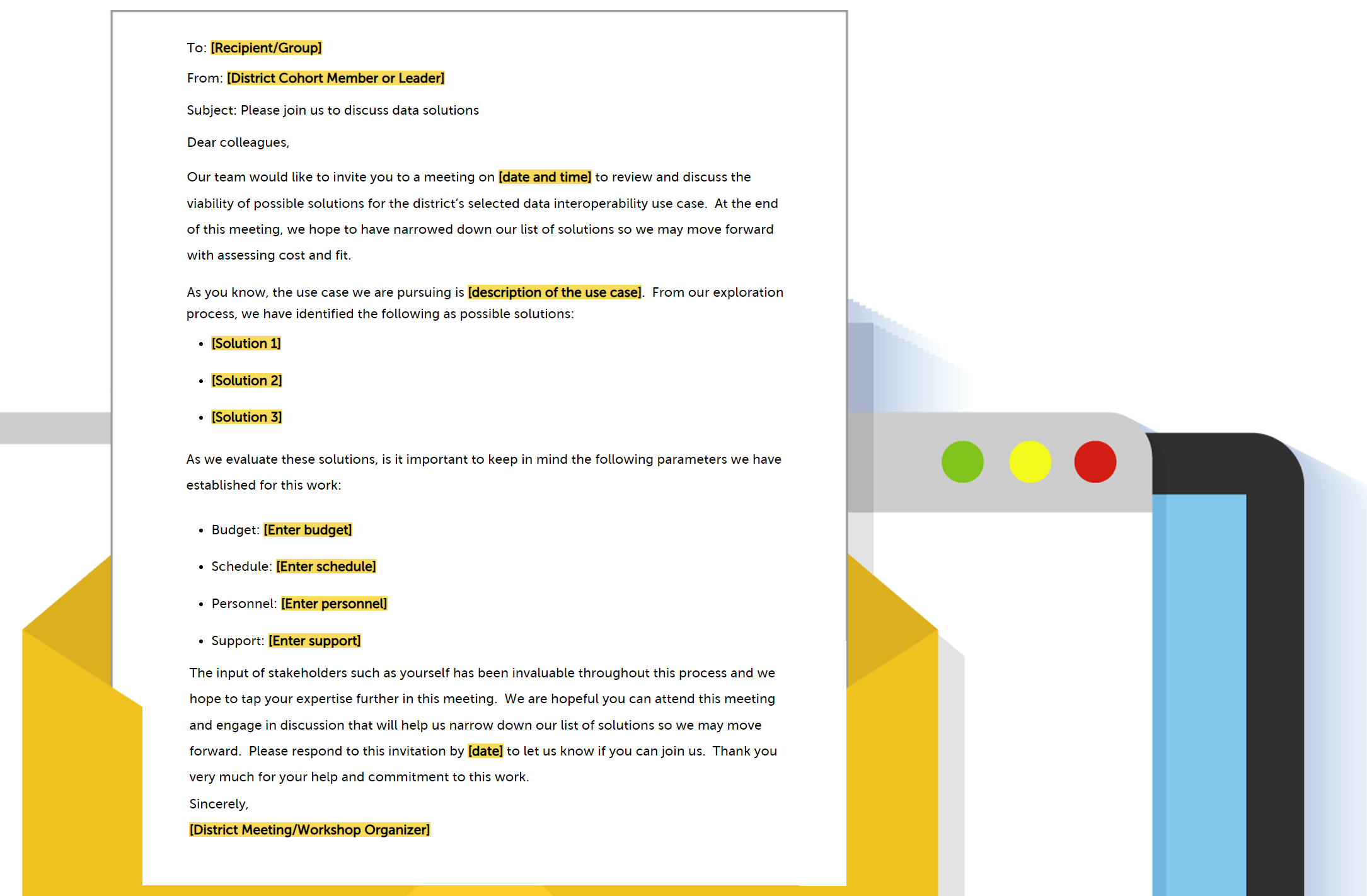Solution Discussion
Overview
When evaluating possible solutions, it is important to keep the end-user experience for varied stakeholders in mind. Once you have identified a few possible solutions, use this email template and the rubric below to establish ongoing discussions with diverse stakeholders around your district’s use case solution.


Use these sample agendas for a series of internal meetings to review the feasibility and viability of possible solutions for your district’s use case.
- SAMPLE AGENDA: INITIAL MEETING
- SAMPLE AGENDA: ADDITIONAL MEETINGS (OPTIONAL)
- SAMPLE AGENDA: FINAL REVIEW OF SOLUTION OPTIONS
This sample agenda can be used to hold a meeting to discuss the first of several options your district is considering or to review a lone option.
| 10 min | Introductions and Level-Setting |
| Solution Overview Describe [Option 1] at high level | |
| 40 min | Review & Discussion Review [Option 1] Detailed solution architecture and data flow of [Option 1] Personnel Needs Budget Implications Timeline Review Evaluate [Option 1] What are the strengths of [Option 1]? What are the drawbacks of [Option 1]? Does [Option 1] solve our district use case completely? |
| 10 min | Next Steps Decision Point Should [Option 1] be removed from consideration, or is it still a viable candidate? |
This sample agenda can be used to hold a meeting to discuss additional options your district is considering. It allows for a review of the solution option, as well as prompts your participants to reflect on previous options to eliminate any from consideration.
| 10 min | Introductions and Level-Setting |
| Solution Overview Describe [Option 2] at high level | |
| 40 min | Review & Discussion Review [Option 2] Detailed solution architecture and data flow of [Option 2] Personnel Needs Budget Implications Timeline Review Evaluate [Option 2] What are the strengths of [Option 2]? What are the drawbacks of [Option 2]? Does [Option 2] solve our district use case completely? How does [Option 2] compare to previously reviewed solutions? |
| 10 min | Next Steps Decision Point Should [Option 2] be removed from consideration, or is it still a viable candidate? Does [Option 2] remove any other options from consideration? |
This final sample agenda is intended to be used to guide a final meeting to evaluate the final options still under consideration if your district has not been able to identify the choice through previous meetings.
| 10 min | Introductions and Level-Setting |
| Solution Overview Final overview of competing options | |
| 40 min | Review & Discussion Review & Evaluate [Option 1] v. [Option 2] Side-by-side architecture and data flow comparison of both options How does each option affect personnel needs? Is the work done by internal resources or contract resources? What are the budgetary implications of each option? Long-term, short-term, ongoing costs Timeline Review Do each of these options meet our district’s deadline? District Use Case Do each of the proposed options fully solve our district’s use case? Does one of the options add value beyond our district’s use case? |
| 10 min | Next Steps Decision Point All options have been reviewed by district stakeholders A district-defined scoring system or decision-making process should be executed to determine the district path forward. |
Sample Scoring Rubric

In addition to vendor demonstrations and external collateral, a non biased system for evaluating technology solutions can be created in many ways. One of the simplest ways to evaluate a proposed solution is to create a rubric that includes key factors in your decision and to assign each proposed solution points based on how well they meet those criteria.
| [Solution Option Name] | |
|---|---|
| Criteria (max points) | Points |
| Data Governance (15) – The solution provides an effective data governance process or refinements to existing processes to facilitate data stewardship, data sharing, and other policies. | |
| Technology Infrastructure (15) – The solution includes a technology stack that is scalable, secure, and maintainable. | |
| Data Privacy and Ownership (15) – District maintains ownership of their data and can control data access and privacy of their sensitive, FERPA-protected data. | |
| Solves District Use Case (25) – The solution addresses all facets of the district-selected use case at the center of the data interoperability project. | |
| Support & Maintenance (15) – The solution has a plan for supporting and maintaining the technical part of the project as well as for end-user support. | |
| Cost (15) – Total estimated cost of the project is within the district’s budget and provides good value for the services provided. | |
| Total Points | |